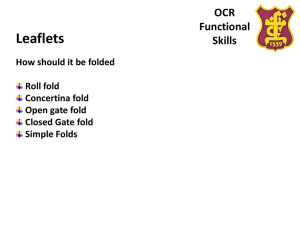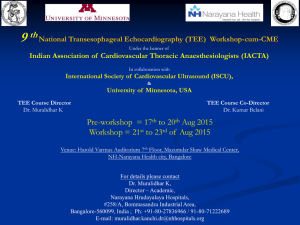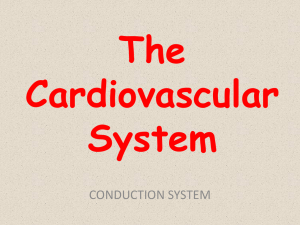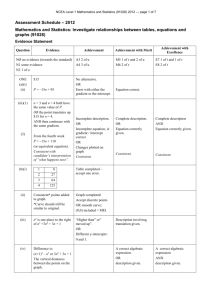Article Outline - JACC: Cardiovascular Imaging
advertisement
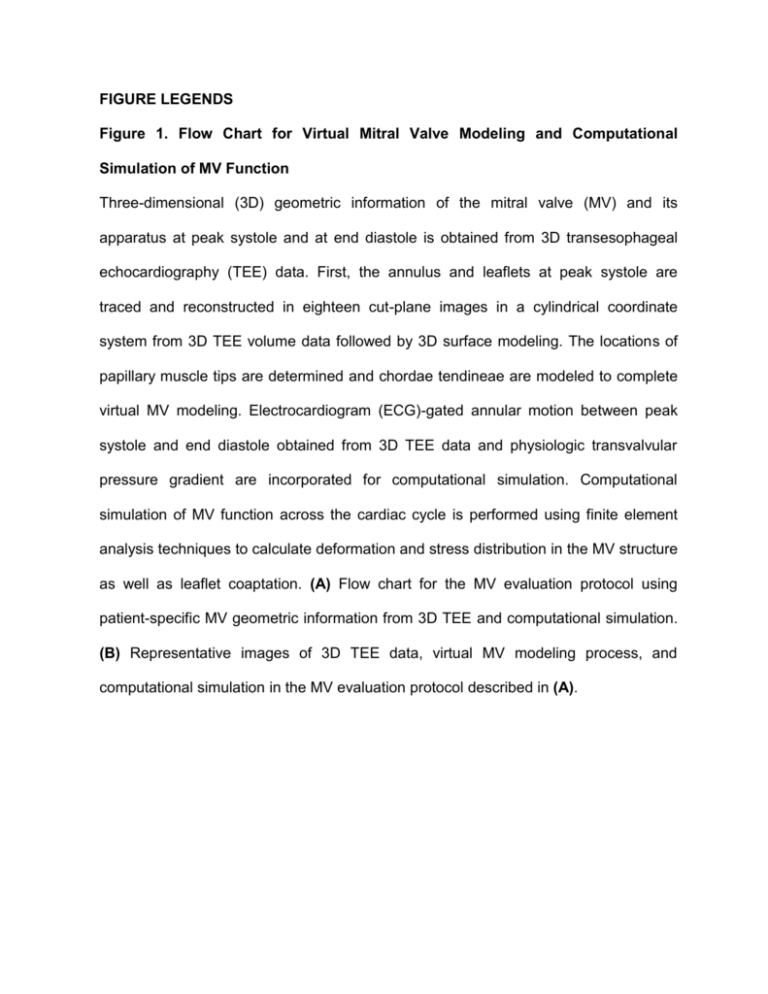
FIGURE LEGENDS Figure 1. Flow Chart for Virtual Mitral Valve Modeling and Computational Simulation of MV Function Three-dimensional (3D) geometric information of the mitral valve (MV) and its apparatus at peak systole and at end diastole is obtained from 3D transesophageal echocardiography (TEE) data. First, the annulus and leaflets at peak systole are traced and reconstructed in eighteen cut-plane images in a cylindrical coordinate system from 3D TEE volume data followed by 3D surface modeling. The locations of papillary muscle tips are determined and chordae tendineae are modeled to complete virtual MV modeling. Electrocardiogram (ECG)-gated annular motion between peak systole and end diastole obtained from 3D TEE data and physiologic transvalvular pressure gradient are incorporated for computational simulation. Computational simulation of MV function across the cardiac cycle is performed using finite element analysis techniques to calculate deformation and stress distribution in the MV structure as well as leaflet coaptation. (A) Flow chart for the MV evaluation protocol using patient-specific MV geometric information from 3D TEE and computational simulation. (B) Representative images of 3D TEE data, virtual MV modeling process, and computational simulation in the MV evaluation protocol described in (A). Figure 2. Images of a Normal MV (A) Volumetric MV images from 3D TEE data demonstrating normal leaflet coaptation (atrial view). Images are displayed from end diastole (left) to peak systole (right). See Online Video 1. (B) Corresponding images of the virtual MV model from computational simulation demonstrating dynamic motion of the saddle-shaped annular morphology and stress distribution over the leaflets. Note that large leaflet stress is observed only near the posteromedial commissural area at peak systole. See Online Video 2. A = anterior; Al = anterolateral; P = posterior; Pm = posteromedial. Figure 3. Images of a Pathologic MV With Posterior Chordal Rupture (A) Volumetric MV images from 3D TEE data demonstrating posterior leaflet prolapse (atrial view). We found that both the P2 and P3 scallops in the flail leaflet were involved with chordal rupture. Images are displayed from end diastole (left) to peak systole (right). More detailed diagnosis and characterization of this pathologic MV are described in Figure 7. See Online Video 3. (B) Corresponding images of the virtual MV model with ruptured chordae from computational simulation clearly demonstrating flail posterior leaflet prolapse in the same region as the 3D TEE images in (A). Note that large stress values are widely spread over not only the flail posterior leaflet but also the anterior leaflet at peak systole. See Online Video 4. Abbreviations as in Figure 2. Figure 4. Case 1 – A Normal MV With Complete Coaptation; A-D (Peak Systole), E-H (End Diastole) (A) Volumetric MV image from 3D TEE data demonstrating normal leaflet coaptation at peak systole (ventricular view). (B) 2D Doppler TEE image at 60 demonstrating a cross-sectional commissural (Al-Pm) view at peak systole; red arrow line in (A). Little regurgitation is observed. (C) Stress distribution across the leaflets at peak systole computed from simulation of MV function (atrial view). The virtual MV model demonstrated relatively symmetric stress distribution across the leaflets and large stress values only in a small region in the anterior leaflet. (D) Distribution of contact pressure between the leaflets demonstrating complete coaptation at peak systole (posterior view). Note that contact pressure for fully closed coaptation was taken as 2.0 kPa (red) for this study. (E) Volumetric MV image from 3D TEE data clearly demonstrating two fully open leaflets at end diastole (ventricular view). (F) 2D TEE image at 0 at end diastole; red arrow line in (E). (G) Stress distribution across the leaflets at end diastole (atrial view). Note that the stress threshold for red color in the legend was set as 0.4 MPa for this study. (H) Morphology of the virtual MV at end diastole, which corresponds to the 2D TEE image data in (F). Abbreviations as in Figure 2. Figure 5. Case 2 – A Degenerative MV With Mild Regurgitation and Small Annular Dilation; A-D (Peak Systole), E-H (End Diastole) (A) Volumetric MV image from 3D TEE data demonstrating defective coaptation (yellow circle) leading to mild regurgitation at peak systole (ventricular view). (B) 2D Doppler TEE image at 60 demonstrating the mild regurgitant jet near the posteromedial commissure region at peak systole; red arrow line in (A). (C) Stress distribution across the leaflets at peak systole computed from simulation of MV function (atrial view). Asymmetrically distributed large stress values were observed across both the anterior and posterior leaflets. (D) Contact pressure distribution demonstrating faulty contact between two leaflets near the posteromedial commissure region (yellow circle) at peak systole, which corresponds to defective coaptation shown in (A). (E) Volumetric MV image from 3D TEE data demonstrating two fully open leaflets at end diastole (ventricular view). (F) 2D TEE image at 0 at end diastole; red arrow line in (E). (G) Stress distribution across the leaflets at end diastole (atrial view). (H) Morphology of the virtual MV at end diastole, which corresponds to the 2D TEE image data in (F). Abbreviations as in Figure 2. Figure 6. Case 3 – A Degenerative MV With Severe Regurgitation and Large Annular Dilation; A-D (Peak Systole), E-H (End Diastole) (A) Volumetric MV image from 3D TEE data clearly demonstrating defective coaptation in the P1 and P2 scallops (yellow circle) leading to mitral regurgitation at peak systole (atrial view). (B) 3D Doppler TEE image demonstrating regurgitation near the anterolateral commissure region at peak systole, which corresponds to the region of defective coaptation in the 3D TEE images (yellow circle) in (A). (C) Stress distribution across the leaflets at peak systole computed from simulation of MV function (atrial view). The computational simulation demonstrated defective coaptation in the anterolateral commissure region (yellow circle). Large stress values are widely spread across both leaflets. (D) Distribution of contact pressure between the leaflets from computational simulation demonstrates that the anterolateral commissure region has no contact between two leaflets (yellow circle) at peak systole (posterior view), which corresponds to defective coaptation and the area of regurgitation shown in (A), (B), and (C). Note the extent of leaflet contact and overall coaptation height are much smaller than for the normal MV displayed in Figure 4 (D). (E) Volumetric MV image from 3D TEE data demonstrating two fully open leaflets at end diastole (atrial view). (F) 3D Doppler TEE image at end diastole. (G) Stress distribution across the leaflets at end diastole computed from simulation of MV function (atrial view). (H) Morphology of the virtual MV at end diastole, which corresponds to the 3D Doppler TEE images in (F). Abbreviations as in Figure 2. Figure 7. Case 4 – A Degenerative MV With Severe Regurgitation due to Ruptured Chordae; A-D (Peak Systole), E-H (End Diastole) (A) Volumetric MV image from 3D TEE data clearly demonstrating flail posterior leaflet prolapse in the P2 and P3 scallops leading to severe regurgitation at peak systole (atrial view). We found that at least two primary chordae tendineae were ruptured and involved in the flail posterior leaflet prolapse. (B) 2D Doppler TEE image at 105 demonstrating the eccentric regurgitant jet parallel to the anterior leaflet surface due to prolapse of the P2 and P3 scallops at peak systole; red arrow line in (A). (C) Computational simulation was performed without modeling the chordae tendineae in the P2 and P3 scallops. Morphology of the virtual MV at peak systole (atrial view) well demonstrated excessive bulging of the posterior leaflet in the P2 and P3 scallops corresponding to the flail posterior leaflet shown in (A). Large stress values were found near the boundaries of the ruptured chordae in both the anterior and posterior leaflets. This indicates that excessive force was induced in the remaining intact chordae around the ruptured ones and large stress concentration was caused across the leaflets near the remaining chordae. This eccentric large stress concentration can further damage leaflet tissue structure leading to tissue failure. The maximum stress value was four times larger than that of the normal MV in Figure 4 (C). (D) Contact pressure distribution from computational simulation demonstrating the prolapsed posterior leaflet with no contact between two leaflets in the P2 and P3 scallops (yellow circle) at peak systole (posterior view), which corresponds to the flail leaflet and severe regurgitation shown in (A), (B), and (C). (E) Volumetric MV images from the 3D TEE data demonstrating two fully open leaflets at end diastole (atrial view). (F) 2D TEE image at 132 (long axis view) at end diastole; red arrow line in (E). (G) Stress distribution across the leaflets at end diastole computed from simulation of MV function (atrial view). Note that the chordae tendineae in the P2 and P3 scallops were not modeled to create chordal rupture in the computational simulation. (H) Morphology of the virtual MV at end diastole, which corresponds to the 2D TEE images in (F). Ao = aorta; other abbreviations as in Figure 2. Figure 8. Assessment of Annular Reaction Force and Chordal Stress Distribution; Normal MV (Case 1) Versus MV With Ruptured Chordae (Case 4) Reaction force distribution exerted along the mitral annulus and chordal stress distribution at peak systole were determined to evaluate the relationships between size and morphology of the annulus, annular reaction force distribution, chordal stress distribution, and MV pathology. (A) Annular force distribution of the normal MV demonstrating relatively symmetric reaction forces along the annulus, particularly with low reaction forces in the posterior annular region (atrial view). (B) Chordal stress distribution for the normal MV demonstrating small stress distribution overall in the chordae tendineae (posterior view). (C) Annular force distribution of the pathologic MV with ruptured chordae demonstrating asymmetric reaction force distribution along the annulus with several regions of large reaction force concentration (atrial view). Note that the regions of large reaction forces correspond to the regions with excessive stress concentrations for both the anterior and posterior leaflets shown in Figure 7 (C). This indicates that large stress concentrations over the leaflets and large reaction force concentrations in the annulus closely interact by sharing and reducing excessively exerted force concentrations to prevent tissue damage. (D) Chordal stress distribution of the pathologic MV with ruptured chordae demonstrating increased stress values in the remaining intact chordae around the ruptured ones in the P2 and P3 scallops (posterior view). This extends the presumption above indicating that intact chordae tendineae play important roles to reduce excessive force concentrations over the MV apparatus. Figure 9. Contact Pressure Distribution Between the Leaflets; Normal MV (Case 1) Versus MV With Ruptured Chordae (Case 4) (A) Images of distribution of contact pressure between the leaflets in the normal MV from computational simulation of MV function across the cardiac cycle (posterior view). Images are displayed from end diastole (left) to peak systole (right). When the two leaflets began contacting, contact pressure increased around the leaflet edge region over time and completed fully closed coaptation at peak systole. See Online Video 5. (B) Images of distribution of contact pressure between the leaflets in the pathologic MV with ruptured chordae across the cardiac cycle (posterior view). The extent of leaflet contact was much smaller than for the normal MV displayed in (A). Contact pressure occurred around the leaflet edge region when the leaflets began coaptation except where chordae were not modeled (P2 and P3 scallops). Note that prolapse of the posterior leaflet occurred as soon as the leaflets began coaptation indicating this pathologic MV creates the regurgitant jet constantly while the MV is closed. See Online Video 6.

